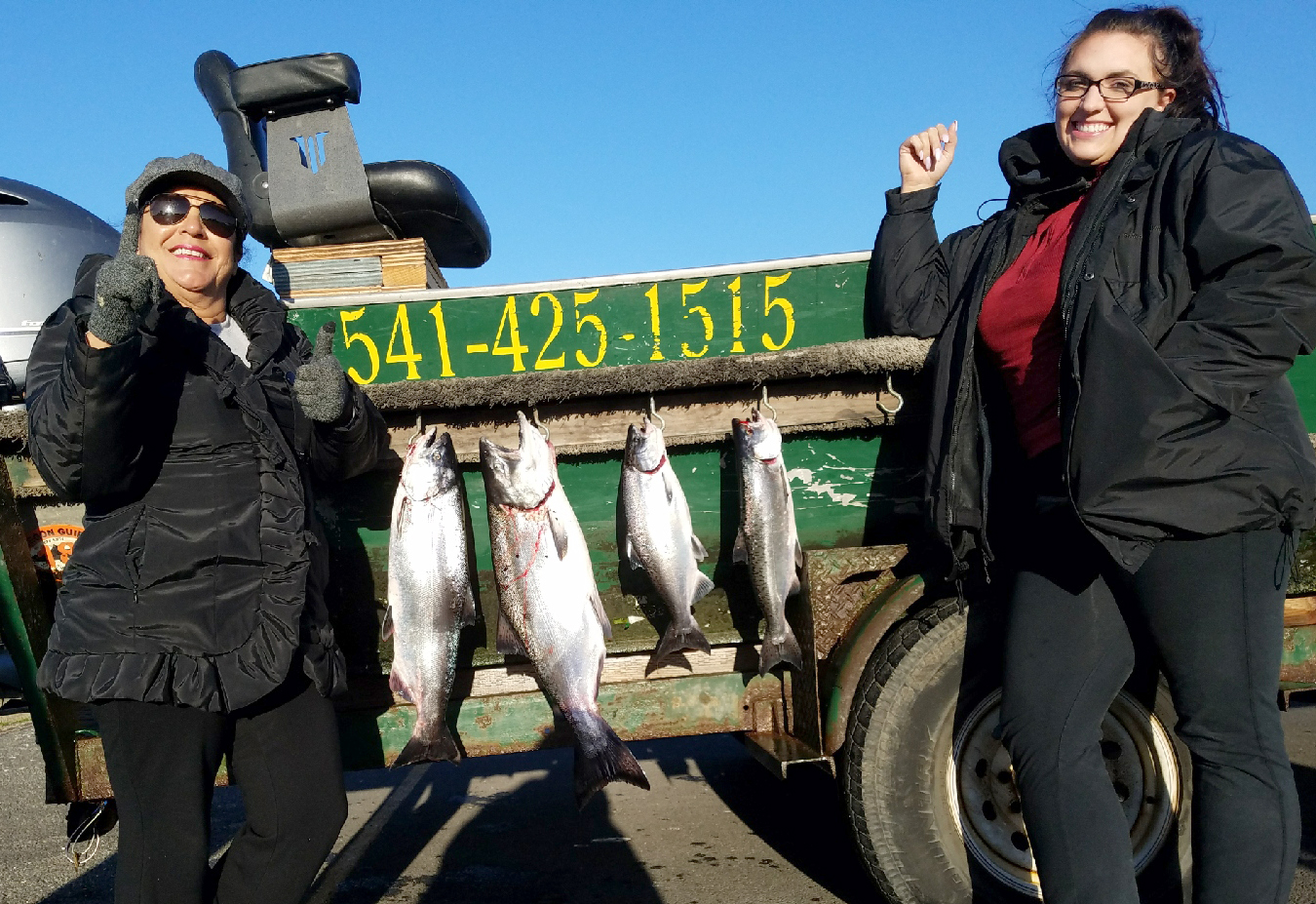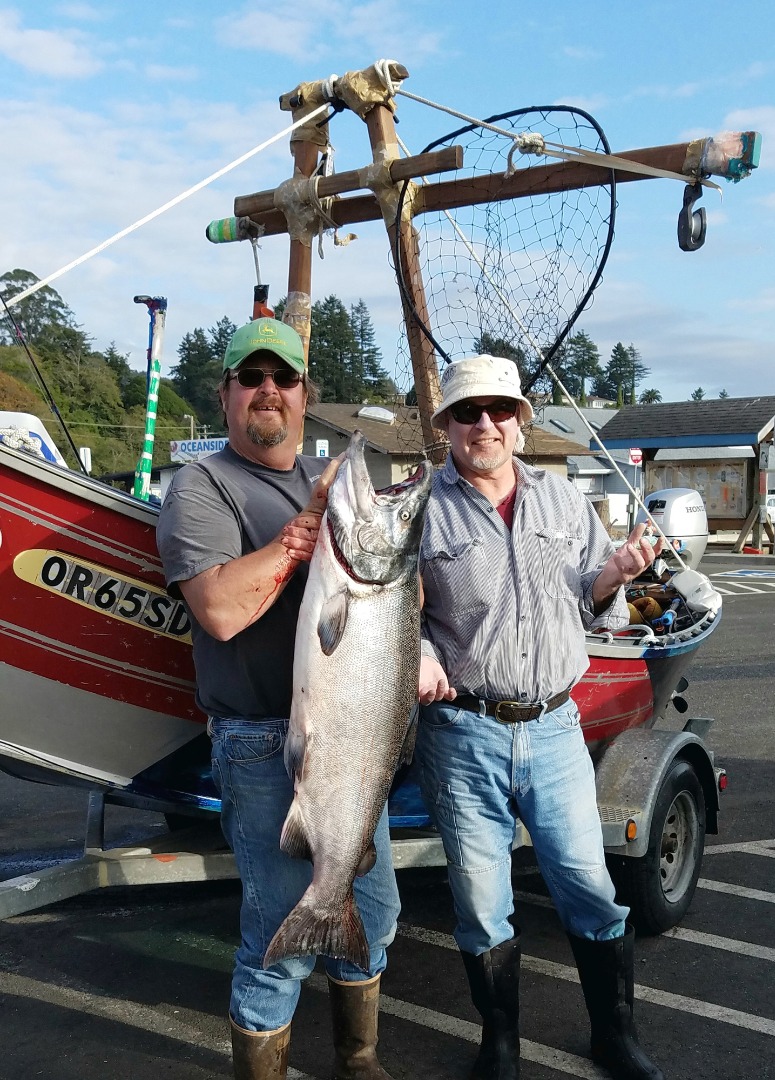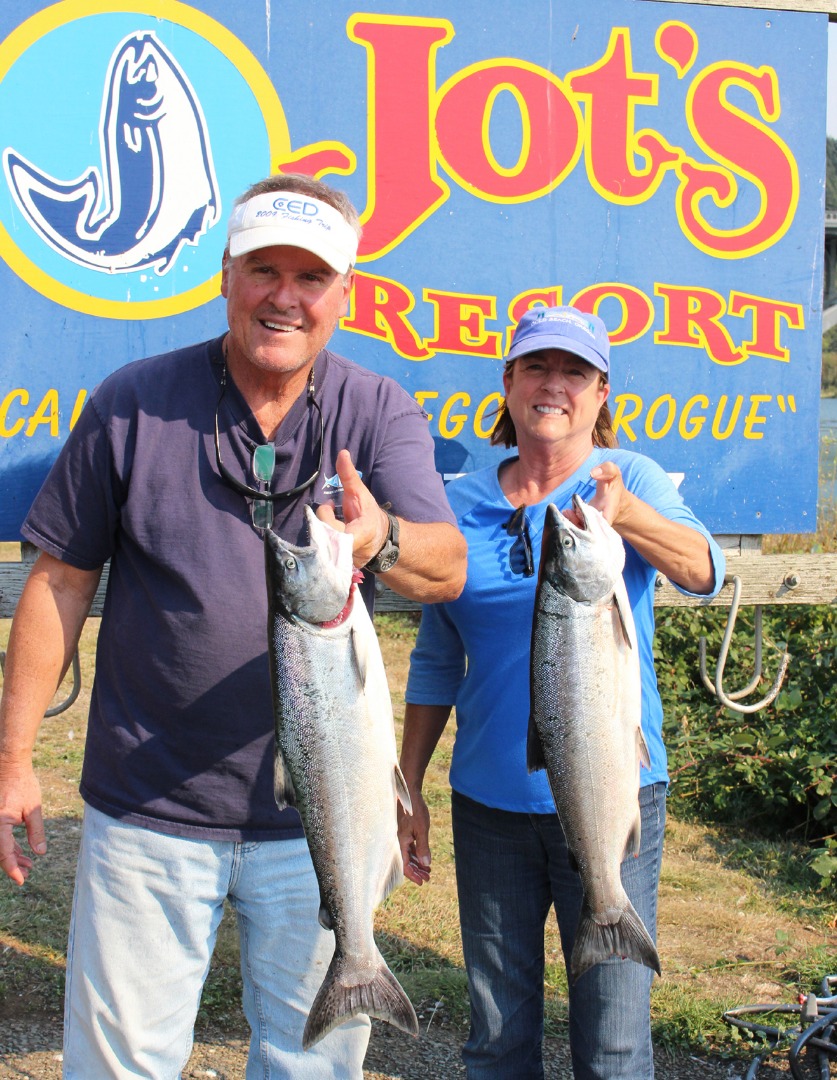Mexican Fish Report
Chetco Bubble Fishery Ends Oct. 14 - Local Bays Still Producing Kings

by Larry Ellis
10-12-2018
Website
The very popular Chetco Bubble Fishery which takes place in state waters started out with two spectacular days on Saturday and Sunday, October 6 and 7. The salmon were stacked up like cordwood between the jaws of the Port of Brookings Harbor, and the bell and whistle buoys. So it was a fisherman’s job to merely seek out the obvious.
Limits were the rule rather than the exception.
But then again, the limit is only one Chinook per day in this fishery. I mean, how much can a person brag about catching one fish?
Not that a limit of one of any fish species is wrong. It’s just that when used in a singular context, the whole concept of mono-salmon limits just kinda-sorta rubs me the wrong way. Ya know what I mean?
If you don’t know what I mean, you’re probably not alone.
But just for the sake of discussion, here’s a typical scenario that always leaves my head spinning, where two anglers are discussing how well they did on the water. It could pertain to any fishery for that matter, but In this particular situation, the relevancy only applies to this year’s Chetco Bubble Fishery.
“So, how did you do today,” one angler asks?
“Well, I limited out,” the other fisherman proudly chimes in (and while struggling to keep a goofy grin from breaking his relaxed, placid complexion).
The first angler that was mentioned is now glowing in such a state of contentment that he (or she) has also limited out, that the first person is now bathing in glorious ecstasy.
Actually, the two anglers have now achieved an altered state that fishermen often strive to attain. They have reached the age of en-limitnous.
Well I don’t know how to break the news to you guys, but when the addition is finally tallied, you have still only caught one fish.
That’s un, uno, unus.
1 – 1 – 1.
Hello – hello – hello!
OK, so I do admit that in the case of one-fish limits, I kinda-sorta, even possibly, might have a little bit of a hang-up. But the good news, at least for me, is that I think I have finally figured out all the whys and wherefores of this enigmatic en-limitnous puzzle.
Reading printed words on a piece of paper that you are limited to only catching one particular fish species is quite OK. In fact, it’s the law, and you better abide by the rules, or G-Loomis doth thou part.
But it’s actually the verbalizing process that sounds a little bit discordant to my ears.
Granted, the salmonid may have given you the battle of a lifetime, and it may have even been a reel wall hanger, but when it comes down to a “limit of one”, saying that you have limited out is just plain wrong.
But I seriously digress.
So now that the first leg of the Chetco Bubble Fishery (October 6-7) is history, we must now attack the second leg of this wonderful ocean extravaganza, the one taking place on October 13 and 14.
The first leg of the adventure was a complete success. I suspect that fishermen did so well because there was a slight front that occurred, complete with precipitation, which bundled the kings up in a small area, right outside the bell and whistle buoys.
The second leg might be a little more challenging. Remember that we discussed watching how well the commercial fishermen did on their first go-a-round of the bubble fishery, which for them took place from October 8 through October 12.
The commercial boys had a slightly more difficult time finding their salmon. I suspect it was because we’ve had all this sunny weather, which made the salmon scatter beyond the boundaries of this fishery.
So, anglers are going to hope and pray for another front to affront the bubble fishery and get the fish ready to bundle up once more and prepare themselves to go up the Chetco River. So keep your eyes and ears peeled to the National Weather Service’s forecasts.
Chetco Bay - Lower Tidewate
Anglers kept trolling the Chetco bay with spinnerbait rigs all last week in the hopes of hooking up with a Chinookzilla. Lots of jack Chinook were caught and there were also some hawgs in the 20- to 35-pound category caught as well.
During the incoming high tide, Chetco Chinook will often head upriver and rest in the deep, cool water of Morris Hole, Tide Rock and finally, Social Security Bar, in that order. Then, as the tide recedes, warm water from the river will push them out of these tidewater holes into the estuary and in the ocean.
They will often head back out to sea, working the tides multiple times. Although they haven’t begun to stack up as of yet, there have been some catches of both jacks and adults by people using the required bobber setup above rivermile 2.2 (page 18 of the Oregon Fishing Regulations).
Early morning is the best time to catch these fish off guard and in their snappiest moods. If an incoming tide happens to coincide with the early morning hours, so much the better.
Seasoned veteran Jason Gutierrez of Brookings landed a large Chinook over 20 pounds and two chrome-bright jacks on Thursday at Social Security Bar by using bobbers and sand shrimp cocktails.
Look for the fishing to pick up as the rains come and cool off the river water. When November 4 rolls around, all legal angling techniques will be permitted on the Chetco.
A second or third run of fresh chromers will make their way up into the lower tidewater holes if there is a drop in barometric pressure and/or rains in the forecast, no matter how small. It just might coincide with the second leg of the bubble fishery.
Meanwhile, anglers will be able to catch these fish, which have been up to 40 pounds, in the Chetco bay until rains finally raise the river to 800 cfs or higher. A lot of the Chinook in both the Chetco Bubble Fishery and in the Chetco bay have been pushing 40 pounds, so I am fairly optimistic that a 50-pound king will turn up at some point.
Port of Brookings Rockfish and Lingcod
Anglers working the local reefs have been able to score on rockfish and lingcod, with most people limiting out.
“We’ve been limiting out our passengers all of the time when the weather has been cooperative,” says Gutierrez, deckhand for the Miss Brooke at brookingsfishing.com. “We’ve been getting some nice rockies and some really big lingcod. People have been stoked at how good the fishing really is.”
Remember that the last day for crabbing in the ocean will be October 15. After that date, anglers will be concentrating their efforts in Charleston Harbor at Coos Bay, and at Winchester Bay at the mouth of the Umpqua.
After October 15, crabbers will still be permitted to take place in inland bays and estuaries. Whichever plan you decide on, make sure to bring plenty of bait with you from Brookings, because the fish barrels at the latter two estuaries may not have easy access. For security purposes, bring plenty of tuna carcasses if you have them. You can fill a crab pot pretty fast using this type of bait.
Rogue Bay Going Strong
Anglers trolling the Rogue Bay with spinnerbaits have been getting plenty of action, whether it’s from Indian Creek Chinook, Rogue Bay Chinook or coho.
“Talking to several of the guides, they’re getting enough action where their clientele are definitely happy,” said Jim Carey, owner/operator of the Rogue Outdoor Store in Gold Beach on Thursday. “The other day, John Anderson (Memory Makers) had 13 fish to the boat. The majority of the action has been with jacks or silvers, but there are definitely still big Chinook out there.”
Anderson said that he knew of 4 or 5 big Chinook caught on the Rogue Bay on Thursday.
“On Wednesday I had four keepers and released 5,” Anderson said on Thursday. “And I’ve been averaging 5 or 6 coho a day.”
Anderson’s been whacking the heck out of his fish using number 3-1/2 or 4 gold Hildebrandt blades, but he has also been doing quite well using orange or green-on-green blades as well. Bright orange, red or hot pink blades are basically coho candy.
Anderson said that the coho have been averaging between 8 and 15 pounds and that on Tuesday he whacked 6 of the silvers.
“So you never know from day to day what you’re going to end up with, but the action is there,” notes Anderson.
So once again, bone up on your coho and Chinook identification, because some of these coho are larger than some of the Chinook. Many Chinook have been unknowingly released, thinking that they were coho, but the opposite of that scenario can also be true.
I always like to check the base of the teeth on the lower jaw. The base of the teeth goes right through the center of the entire lower jaw. This is important information because even the best Chinook and coho fishermen have often been fooled by wrongful identification.
To be on the safe side, check out page 95 on the Oregon Sportfishing Regulation pamphlet for the best pictures on this subject.
Tight lines!
Larry Ellis, author, writer, columnist and photographer has had a 50-year passion for fishing in California and Oregon's saltwater and freshwater venues. He is a well-known writer for Oregon, Washington and California Fishing and Hunting News, Northwest Sportsman, California Sportsman and Pacific Coast Sportfishing. He currently writes monthly for Salmon Trout Steelheader Magazine, and is the author of two books, "Plug Fishing for Salmon" and "Buoy 10, the World's Largest Salmon Run." Both books can be bought from Amato Publications (amatobooks.com), Amazon and eBay. Ellis particularly loves living in his hometown of Brookings, Oregon - The heart of salmon country and gateway to fishing paradise.
Photos
More Reports
Southern Oregon Bays Producing Salmon
Rogue Bay
10-6-2018
An unusually high amount of jack Chinook with a few big kings mixed in crossed the Rogue and Chetco bars...... Read More

9-29-2018
The Rogue bay is still producing enough Chinook to keep boaters trolling in the estuary. The sizes have ranged to...... Read More


